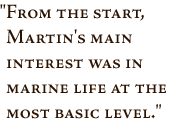

|
Born in Old Lyme, Connecticut, on February 27, 1935, John Martin had an ideal New England childhood. He did reasonably well in school, participated in sports, and enjoyed fishing and hiking in the woods of Connecticut and Maine with his family. Martin’s comfortable life, however, came to an abrupt halt when he was diagnosed with polio just prior to his sophomore year at Colby College. The disease hospitalized him for nine months, several of which he spent in an iron lung. But the polio neither broke his spirit nor deterred him from his goals. Through a diet of swimming and rehabilitation exercises, Martin brought himself to the point where he was able to walk with canes. He then managed to finish college within three years after his recovery. “Through these adversities, John adopted the tenacity and drive that served him in his career,” says Marlene Martin, John Martin’s widow. At the urging of his father, an influential conservationist in Connecticut, Martin enrolled in the graduate program for marine zoology at the University of Rhode Island. From the start, Martin’s main interest was in marine life at the most basic level. He wanted to explore those conditions and basic nutrients in the sea that regulate the growth of phytoplankton and zooplankton (tiny animals that feed off phytoplankton). At the University of Rhode Island, in his doctoral thesis he examined the role that zooplankton play in changing the levels of nutrients, such as nitrogen and phosphorus, that regulate algae in Nantucket Bay. Shortly after receiving his Ph.D., Martin landed a job in Puerto Rico, working for the Nuclear Regulatory Commission (NRC). He was assigned the task of testing the long-term effects of nuclear radiation on phytoplankton in the region. The NRC and the U.S. Army Corps of Engineers were toying with the idea of detonating nuclear weapons throughout Panama to widen the Panama Canal and separate North and South America once and for all. Most scientists involved in the project, including Martin, were against the idea. Not only would the explosions contaminate the entire food web, but they would also shatter every window in Panama City. The project was scrapped in the end. It was in Puerto Rico that Martin met his wife Marlene, who worked for the Peace Corps. She says she first met John Martin when she was trying to hunt down someone to help her understand why the poor fishermen in the village of Mayaguez could hardly support themselves with the number of fish they brought in. Marlene recounts,“When I met John, I sized him up and I decided I didn’t like him. I thought he was too preppy. John later told me that the minute I walked through the door, he knew he wanted to marry me.” John Martin did everything possible to help her in her assignment in Puerto Rico, and he made sure he never lost contact. Despite Marlene’s initial misgivings, she eventually came around. In 1969 they married and settled down in Monterey Bay, California, where she teaches English at Monterey Peninsula College. “He was following his instincts. They were correct. It was a great marriage,” says Marlene Martin. next: An ocean full of metal
|
 On the Shoulders of Giants
| ||